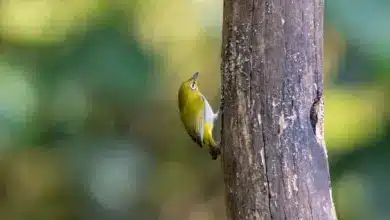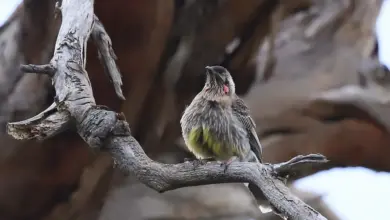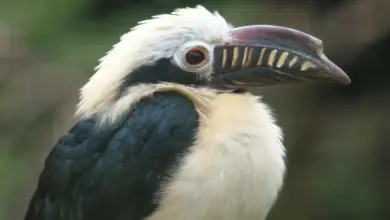Red-bellied Paradise Flycatchers (Terpsiphone rufiventer)
The Red-bellied Paradise Flycatchers (Terpsiphone rufiventer) – also known as the Black-headed Paradise Flycatchers – are common breeders in tropical western and central Africa where they have a fairly large range south of the Sahara Desert.
This species is usually found in thick forests and other well-wooded habitats. They are believed to be migratory; but little is known about their migration pattern.
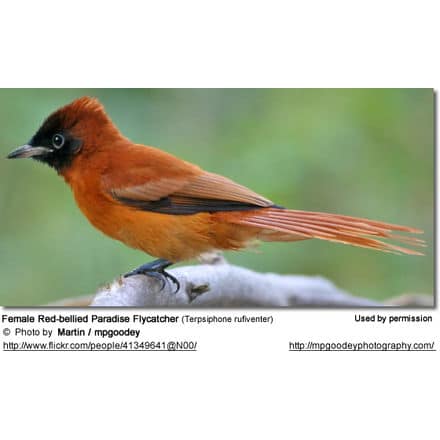

Subspecies and Ranges:
- Black-headed Paradise-flycatcher (Terpsiphone rufiventer rufiventer – Swainson, 1837) – Nominate form
- Range: Senegal south to Gambia and western Guinea.
- Black-headed Paradise-flycatcher (Terpsiphone rufiventer nigriceps – Hartlaub, 1855)
- Range: Sierra Leone and Guinea east to Togo and southwestern Benin.
- Fagan’s Paradise-Flycatcher (Terpsiphone rufiventer fagani – Bannerman, 1921)
- Range: Benin and adjacent southwestern Nigeria.
- Ashy-tailed Paradise-Flycatcher (Terpsiphone rufiventer tricolor – Fraser, 1843)
- Range: Bioko Island (also known as Fernando Póo) situated off the west coast of Africa (Cameroon).
- Cameroon Ashy-tailed Paradise-Flycatcher (Terpsiphone rufiventer neumanni – Stresemann, 1924)
- Range: Southeastern Nigeria south to Cameroon and Gabon to northwestern Angola – namely the province of Cabinda (also spelled Kabinda).
- Black-headed Paradise-Flycatcher (Terpsiphone rufiventer schubotzi – Reichenow, 1911)
- Range: Southeastern Cameroon east to southwestern Central African Republic and south to northeastern People’s Republic of the Congo.
- Black-headed Paradise-Flycatcher (Terpsiphone rufiventer mayombe – Chapin, 1932))
- Range: Southern People’s Republic of the Congo east to western Democratic Republic of the Congo.
- Terpsiphone rufiventer somereni (Chapin, 1948)
- Range: Western and southern Uganda.
- Uganda Black-headed Paradsie-Flycatcher (Terpsiphone rufiventer emini – Reichenow, 1893)
- Range: Southeastern Uganda east and south to western Kenya and northwestern Tanzania.
- Fiery Paradise-Flycatcher (Terpsiphone rufiventer ignea – Reichenow, 1901)
- Range: Southeastern Central African Republic and Democratic Republic of Congo south to northeastern Angola and northwestern Zambia in Southern Africa.Hybridizes at low rates with the Bedford’s Paradise Flycatcher (Terpsiphone bedfordi), where their ranges overlap
- [Terpsiphone rufiventer smithii (Fraser, 1843)] – Sometimes considered a separate race
- Range: Annobón Island located in the South Atlantic Ocean
Description
The adult male Red-bellied Flycatcher measures about 6.5 – 7 inches (16.5 – 17.8 cm) in length without the long tail streamers, which – if included – would nearly double that size. The legs are short and this bird sits very upright whilst perched. His plumage is mostly red chestnut colored, except for the glossy black head and black wingbars. However, there are considerable color variations. There is a morph (genetic mutation) of this species in which the male has the chestnut parts of the plumage replaced by white, and some races have black tail streamers.
The adult female lacks the long the tail streamers and her plumage is duller.
The medium grey-blue beak is broad and slightly hooked at the end.
Juveniles have a brown plumage.
Hybrids: The Red-bellied Paradise Flycatcher interbreeds with the related black-bellied African Paradise Flycatcher. The under plumage of hybrids is a mixture of black and red.
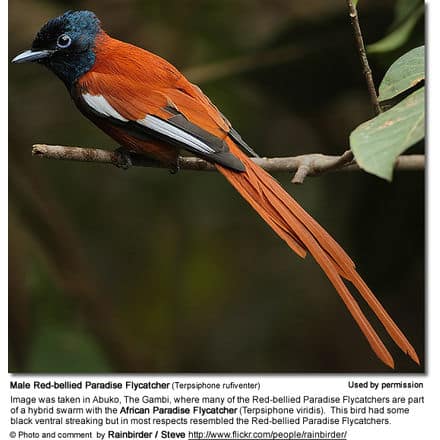
Diet / Feeding
They mostly feed on various insects that are usually caught mid-air and, occasionally, while perched. They may join mixed feeding flocks.
Breeding / Nesting
Black-bellied Paradise-flycatchers form monogamous pair bonds. Females are believed to choose their mates based on the length of their tail streamers.
The average clutch consists of two eggs that are laid in a small, yet deep, cup nest that is usually placed in a fork on a tree branch – about 3 – 10 feet (~1 – 3 meters) off the ground.
Pairs aggressively defend the nest and their young. Several pairs are known to nest in close proximity to each other and jointly defend the area around the nests against predators and invaders.
Calls / Vocalizations / Sounds
The Red-bellied Paradise Flycatchers are noisy birds with a range of vocalizations from song-like whistles to harsh calls, including a sharp zweet call.
Alternate (Global) Names
Chinese: ???? … Czech: Lejskovec rudobrichý … Danish: Rødbuget Paradismonark … Dutch: Roodbuik Paradijsmonarch … Finnish: Punaparatiisimonarkki … French: Gobemouche paradis à ventre roux … German: Senegal Paradiesschnäpper … Italian: Pigliamosche del Paradiso ventrerosso … Japanese: Akaharasankouchou … Norwegian: Rødbukparadismonark … Polish: Muchod?awka rdzawa … Slovak: Vípkár cervenobruchý … Spanish: Monarca Paraíso de Vientre Rojo … Swedish: Röd paradisflugsnappare … Swahili: Chechele Tumbo-jekundu


